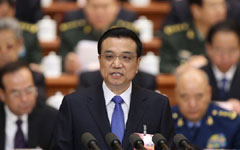There's heated debate in China about whether the government will cut banks' required reserve ratio, which has been steady for 22 months.
If history is any guide, the central bank would have acted already.
Credit growth is weak, the property market appears to be headed toward a correction, and industrial activity is sluggish, all of which points to a stimulus. But the People's Bank of China hasn't moved.
| PBOC eases liquidity through reverse repos |
 |
PBOC Governor Zhou Xiaochuan said last weekend that the economy does not need a "large-scale stimulus".
Stephen Green, a China economist with Standard Chartered Plc, said that the governor might view a reserve ratio cut as such a move.
Banks' current reserves at the PBOC total 21 trillion yuan ($3.4 trillion), so cutting the ratio by 0.5 percentage point would free up about 1 trillion yuan.
By comparison, total social financing-the broadest measure of credit in China, which takes in many sources of funding beyond banks-was 1.55 trillion yuan in April.
The PBOC's stance is in line with a comment by President Xi Jinping, who said China's economic situation has entered into a "new normal". A major feature of the "new normal" is deleveraging. High leverage has built up over the past few years amid easy credit, while real economic growth has grown much less responsive to monetary stimulus.
As the global financial crisis deepened from September 2008 onward, the PBOC cut the reserve ratio by a total of 2.5 percentage points.
But current conditions are more like those in 2011, featuring slowdowns in industrial activity and housing. In 2011, the PBOC cut the reserve ratio by a total of 1 percentage point.
